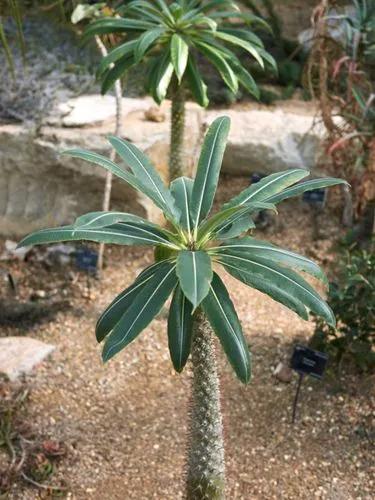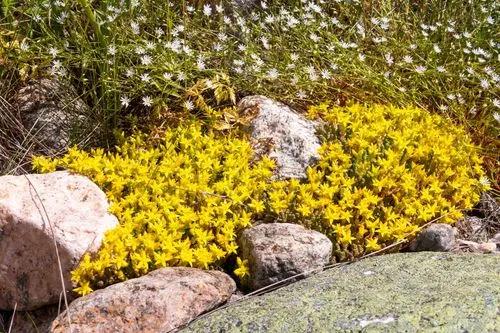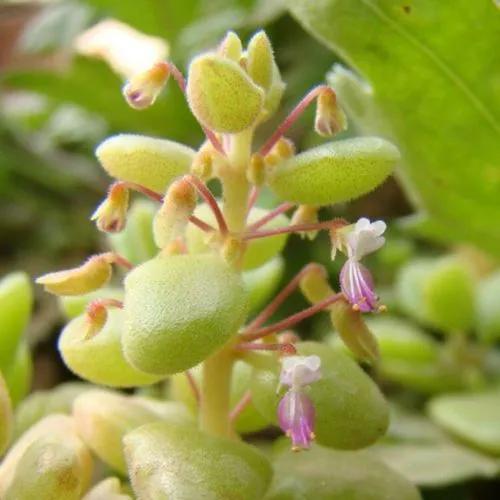Delicate, trailing, miniature. Merely a few words to describe Dischidia geri, an attractive evergreen houseplant. It is a botanical treasure that has enchanted many plant lovers around the world.
Dischidia Geri Care
Dischidia 'Geri'



Commonly known as Pebble Beach, Button Orchid, and Ant Plant, Dischidia geri is a perennial evergreen species of the Apocynaceae family. Native to the tropical rainforests of Southeast Asia, this trailing greenie is closely related to the Hoya plant and produces glossy, thick, and velvety-textured lance-shaped foliage. Pebble Beach plant has a trailing growing habit and can reach up to 6 feet (2 m) if not pruned. Despite being cultivated for its distinctive foliage, Button Orchid produces tiny, white, inconspicuous flowers in Spring or Summer.
How to Care for the Plant

Water

It's recommended to let the soil dry out completely between hydrations. Check the potting mix with a wooden chopstick and water the plant once a week in summer and once every two weeks in winter.

Pruning

It's recommended to trim Button Orchid regularly, as this trailing plant can reach up to 6 feet (2 m) long. Prune the plant when needed, and remember to cut under the node. Trim no more than one-third of the foliage at a time so as not to harm this leafy greenie.

Fertilizer

This trailing greenie is not a heavy-feeder and doesn’t require fertilizing. Once-a-year replanting would be more than enough for this plant.

Sunlight

It’s best to place the Pebble Beach plant in a bright place with indirect light. If this plant doesn’t receive enough light, it becomes leggy. It’s best to put Button Orchid not far from the east or west-facing window.

Soil

As a drought-tolerant plant, Pebble Beach feels best in a well-draining, airy soil combined for epiphytic plants. Plant this greenie in a slightly acidic to slightly alkaline potting mix with a 6-7.5 pH level. It’s recommended to amend the soil drainage with sand or perlite and put 2 in (5 cm) of pebbles to the bottom of the pot before planting.

Propagation

Stem cutting is the quickest way to propagate Pebble Beach. Prune a healthy 6-8 in (15-20 cm) long stem under the node and remove lover leaves. Dip the cutting into the rooting hormone powder and place it in a well-draining potting mix. Keep the stem under indirect light and moisten the ground regularly to let it enroot.

Temperature

A warm temperature between 64-85°F (18-29°C) would be the most comfortable for Pebble Beach. The plant also enjoys high humidity, so it’s recommended to mist it daily during the hot summer months.

Container

As the Button Orchid plant prefers a well-draining potting mix, it’s recommended to choose a pot that will allow proper root aeration. Opt for a container made of porous materials such as terracotta or unglazed clay. It’s recommended to choose a container that is 2-3 times bigger than the plant's root ball. The pot should also have drainage holes to prevent root rot issues.

Fun fact

Dischidia geri has a special relationship with ants. These insects live in perfect symbiosis with the plant. Button Orchid provides shelter and food sources for the ants, while they offer protection and help disperse the plant's seeds. This is where Dischidia geri its common name the ‘Ant Plant’.

Popularity

50 people already have this plant 2 people have added this plant to their wishlists

Common pests

Aphids, mealybugs, and scale insects tend to affect Pebble Beach the most often. If you notice any infestation signs like webbing or yellowing leaves, treat the plant with neem oil or insecticidal soap.

Frequent diseases

Button Orchid can fall victim to leaf-spot disease, botrytis, powdery mildew, and root rot. In case you spot any infection signs on the foliage, replant the greenie with fresh soil and treat the whole plant with a fungicide.

Botanist’s tips

Discover more plants with the list below
Popular articles






